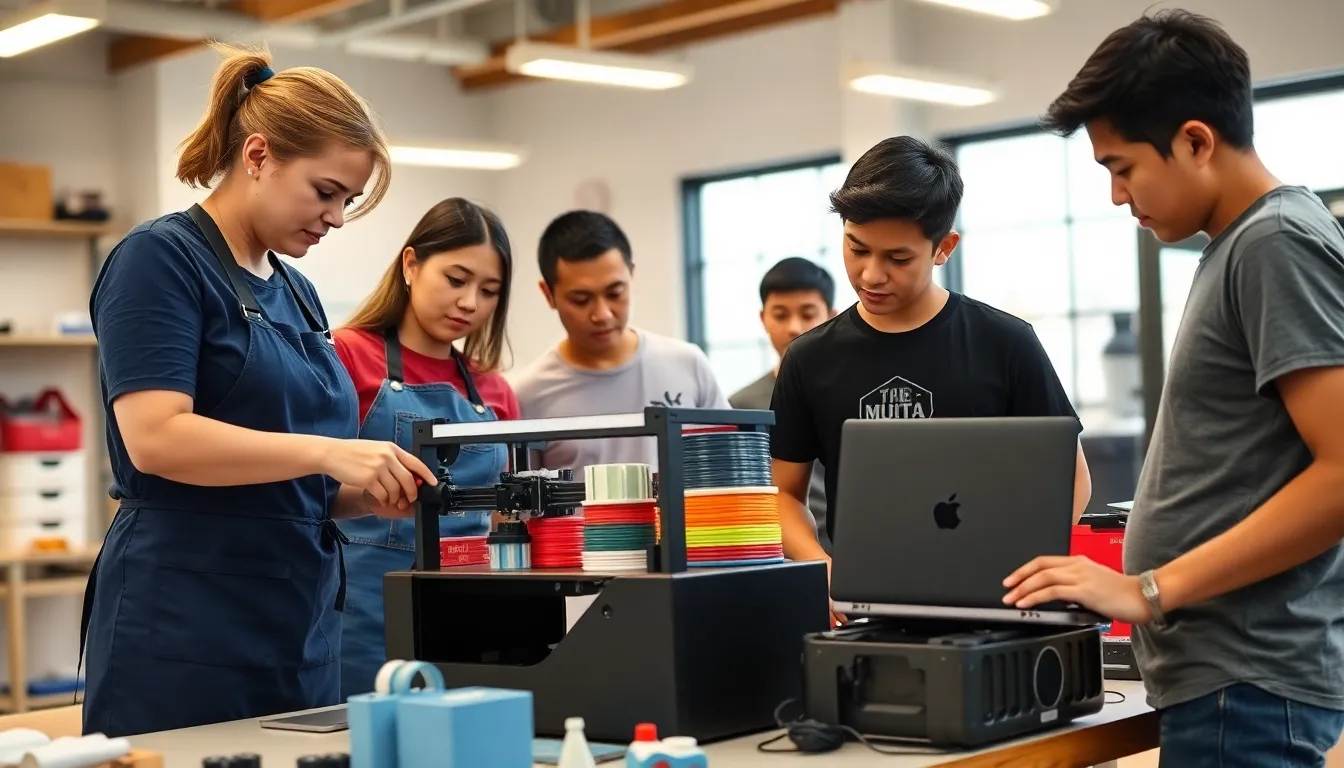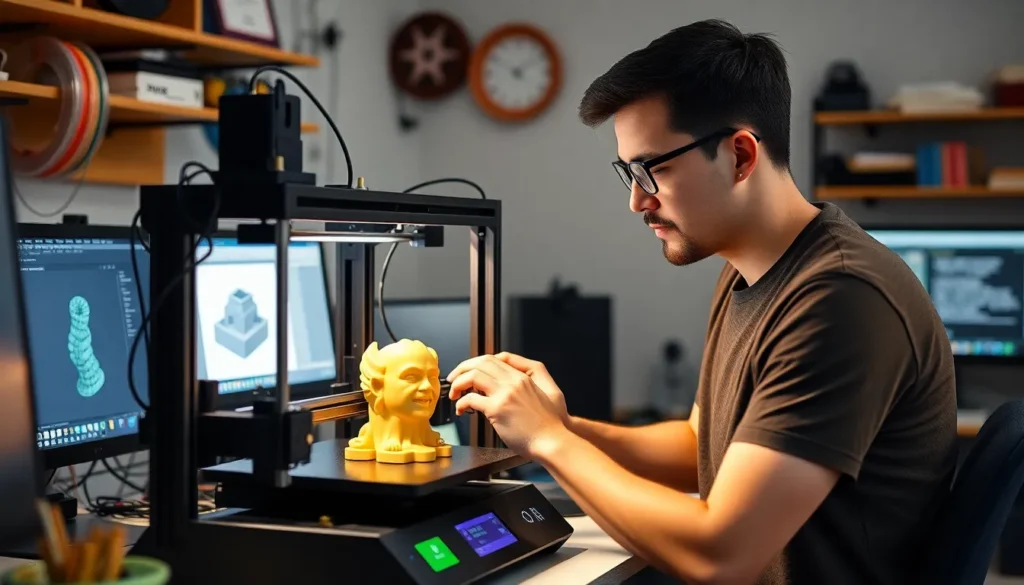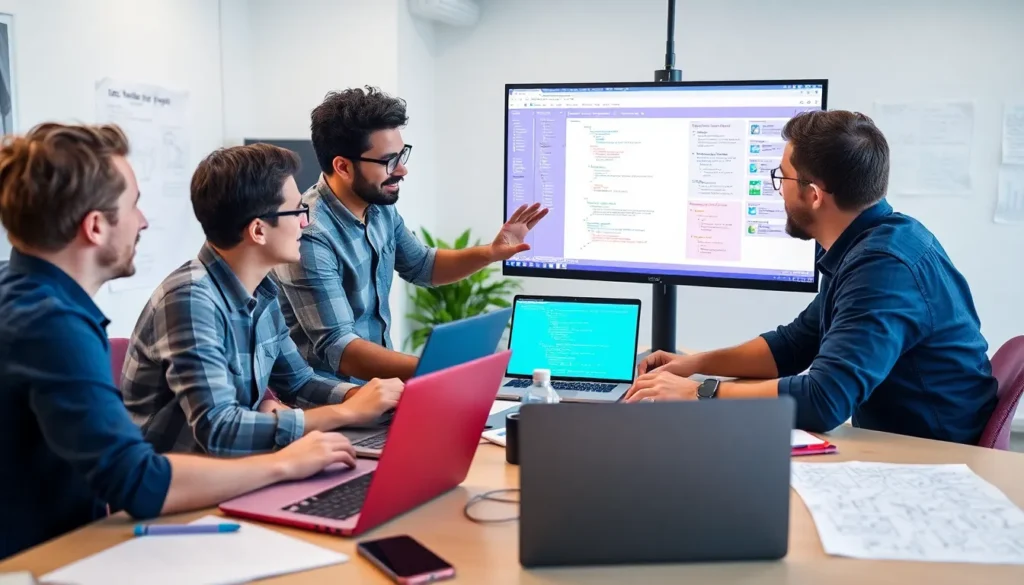Imagine a world where your wildest design dreams come to life with just a few clicks. That’s the magic of 3D printing! Whether you’re a hobbyist looking to create quirky gadgets or a professional aiming to revolutionize your business, mastering 3D printing opens up a universe of possibilities.
But let’s be real—diving into the world of 3D printing can feel like trying to assemble IKEA furniture without the instructions. Fear not! This article is packed with engaging tutorials that’ll guide anyone from novice to pro in no time. Get ready to unleash your creativity and maybe even impress your friends with your newfound skills. Who knew making things could be this much fun?
Table of Contents
ToggleOverview of 3D Printing Tutorials
3D printing tutorials provide valuable resources for individuals interested in mastering this innovative technology. These tutorials cover essential concepts and techniques to enhance skills in 3D printing.
Importance of Learning 3D Printing
Learning 3D printing opens up new possibilities for creativity and problem-solving. Individuals can create custom designs tailored to their specific needs. Understanding the fundamentals of 3D printing helps in developing a strong foundation for future projects. Ease of access to various tools and materials also encourages experimentation. Furthermore, mastering 3D printing skills can lead to career opportunities in fields like engineering, manufacturing, and design. Engaging in this learning process fosters both innovation and critical thinking.
Types of 3D Printing Tutorials
Numerous tutorials cater to different skill levels and interests. Beginner tutorials concentrate on basic 3D printing concepts and software applications. Intermediate tutorials delve into advanced modeling techniques and material choices. Expert-level tutorials often focus on specialized topics, such as creating functional prototypes or integrating electronics. Video tutorials offer visual guidance, while written guides often provide step-by-step instructions. Additionally, community-driven tutorials include user-generated content, sharing experiences and solutions. These diverse formats help learners choose the best method for their learning style.
Getting Started with 3D Printing

Beginning the journey into 3D printing requires understanding essential equipment and software. Knowing what to gather makes the process smoother.
Essential Equipment for Beginners
First, a 3D printer serves as the primary tool. Options such as FDM printers and resin printers suit various needs. Next, filament or resin is crucial for creating prints, with PLA being a popular choice for beginners. Quality control tools, like calipers and scales, assist in precision measurements. Additionally, a print bed surface enhances adhesion, preventing failures during projects. Keeping spare nozzles on hand addresses potential clogs. Basic cleaning supplies, like isopropyl alcohol, ensure maintenance of the printer remains simple. Lastly, a computer or laptop becomes integral for managing designs and software.
Software and Tools Needed
Choosing the right software plays a vital role in successful 3D printing. Free options like Tinkercad offer user-friendly interfaces suitable for beginners. Blender and Fusion 360, while more advanced, provide powerful features for detailed modeling. Additionally, slicer software, such as Cura or PrusaSlicer, prepares designs for printing. Quality slicer software optimizes settings for different materials and printers. Cloud-based platforms enable collaboration and storage, enhancing project management. Community-driven forums and tutorials provide additional resources, making it easier for beginners to gain support and knowledge. Having the right combination of software sets the foundation for successful 3D printing.
Step-by-Step Tutorials
The section offers detailed tutorials designed to guide learners through various levels of 3D printing. These step-by-step guides make it easier to grasp essential concepts and skills.
Basic 3D Printing Tutorial
Begin with an introduction to 3D printing basics. Select a user-friendly software like Tinkercad to create simple designs. Use templates provided by the software for a smoother learning experience. Adjust dimensions and features to understand design principles better. Export the design in a compatible format, typically STL, before moving on. Set up the 3D printer according to the manufacturer’s instructions. Choose PLA filament for initial prints due to its ease of use. Monitor the first layer closely to ensure proper adhesion on the print bed. Celebrate successful prints, as they build confidence in the 3D printing process.
Advanced Techniques and Projects
Transition into advanced techniques for seasoned users. Explore complex software like Blender to create intricate models. Utilize sculpting tools and modifiers to refine designs. Experiment with multi-material printing to offer varied textures and colors. Consider optimizing print settings, including layer height and infill percentage, for enhanced durability. Investigate methods for post-processing, such as sanding and painting, to achieve professional results. Collaborate with online communities to gain insights and feedback. Engage in projects that challenge creativity, like functional prototypes or artistic sculptures. Embrace the learning opportunity presented through these advanced projects.
Resources for Continued Learning
Different resources exist for those wanting to deepen their understanding of 3D printing. Utilizing these can enhance skills and expand creativity.
Online Courses and Websites
Numerous online platforms offer structured courses focused on 3D printing. Websites like Udemy, Coursera, and LinkedIn Learning provide comprehensive lessons from industry experts. Each platform typically includes video lectures and practical exercises that reinforce learning. Many courses target specific interests, such as modeling techniques, printer operation, or material selection. Using these courses helps individuals grasp complex concepts at their own pace, ensuring tailored learning experiences.
Community Forums and Support
Engaging with community forums can significantly boost 3D printing knowledge. Websites like Reddit’s r/3Dprinting and dedicated forums host discussions among enthusiasts and professionals alike. Participants often share tips, troubleshoot issues, and exchange project ideas. Gaining insights from others’ experiences can save time and enhance skills. Many forums also provide access to a wealth of shared resources, including guides, videos, and recent advancements in 3D printing technology. Actively contributing to these communities fosters collaboration and continued growth in this innovative field.
Exploring the world of 3D printing opens doors to endless creativity and innovation. With the right tutorials and resources, anyone can transform their ideas into tangible creations. Embracing the learning process not only enhances skills but also fosters a sense of community among enthusiasts.
As individuals progress from beginners to experts, they’ll discover new techniques and applications that can elevate their projects. Engaging with various platforms and forums will further enrich their journey. By taking these steps, they can fully harness the potential of 3D printing and embark on a rewarding path of creativity and problem-solving.





